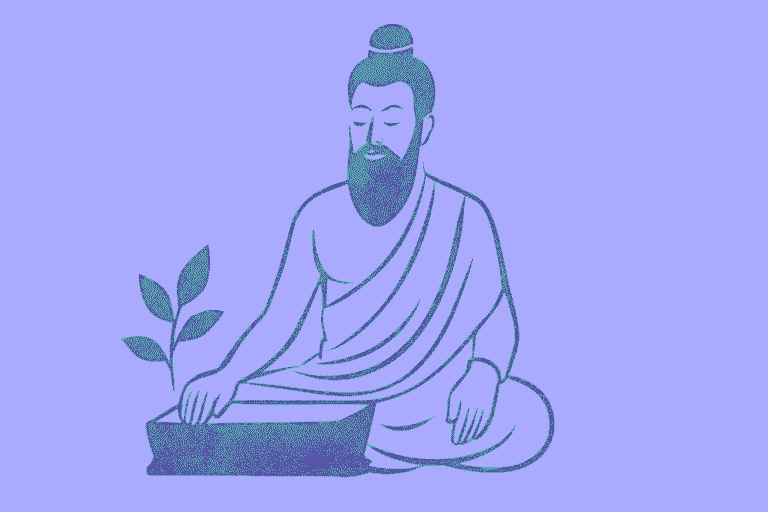contact@cayeit.com
Introduction to Ayurveda and Natural Resources
Ayurveda, the ancient Indian system of medicine, has been promoting the use of natural resources in diet and medicine for thousands of years. This holistic approach to health and wellness emphasizes the importance of living in harmony with nature and utilizing the bounty of the earth to maintain balance within the body, mind, and spirit. By relying on natural materials, Ayurveda not only supports the well-being of individuals but also contributes to the sustainability of our planet.
The principles of Ayurveda are deeply rooted in the belief that everything in the universe is interconnected. This understanding extends to the relationship between human health and the environment. Ayurvedic practitioners recognize that the quality of the natural resources we consume directly impacts our physical, mental, and emotional well-being. Therefore, they place great emphasis on using pure, organic, and minimally processed ingredients in both dietary and medicinal preparations.
One of the key aspects of Ayurveda’s approach to natural resources is its focus on locally sourced materials. By utilizing plants, herbs, and minerals that are native to a particular region, Ayurvedic practitioners ensure that the ingredients are fresh, potent, and well-suited to the needs of the local population. This not only maximizes the therapeutic benefits but also reduces the carbon footprint associated with transportation and supports local ecosystems and economies.
Moreover, Ayurveda’s reliance on natural resources encourages sustainable farming practices. Many Ayurvedic herbs and plants are grown using organic methods, without the use of harmful pesticides or chemical fertilizers. This approach preserves the integrity of the soil, water, and air, while also protecting the health of farmers and consumers alike. By promoting sustainable agriculture, Ayurveda helps to maintain the delicate balance of our ecosystems and ensures the availability of these valuable resources for future generations.
Ayurvedic Diet and Natural Resources
The Ayurvedic diet is centered around the use of whole, unprocessed foods that are rich in nutrients and easy to digest. This approach to nutrition emphasizes the consumption of fresh fruits, vegetables, whole grains, legumes, nuts, and seeds, all of which are sourced directly from nature. By avoiding processed and refined foods, the Ayurvedic diet minimizes the ecological impact of food production and packaging, while also supporting the health and vitality of the individual.
One of the key principles of the Ayurvedic diet is the concept of eating according to one’s dosha, or constitutional type. Ayurveda recognizes three primary doshas – Vata, Pitta, and Kapha – each of which is associated with specific physical and mental characteristics. By consuming foods that pacify and balance one’s dominant dosha, individuals can optimize their digestion, energy levels, and overall well-being. This personalized approach to nutrition ensures that each person receives the specific nutrients they need, while also minimizing waste and overconsumption.
In addition to whole foods, the Ayurvedic diet incorporates a variety of herbs and spices that are known for their therapeutic properties. These natural ingredients not only add flavor and aroma to meals but also support digestion, boost immunity, and promote detoxification. Some commonly used Ayurvedic spices include turmeric, ginger, cumin, coriander, and fennel, all of which are derived from plants and have been used for centuries in traditional medicine.
Another important aspect of the Ayurvedic diet is the emphasis on seasonal eating. Ayurveda recognizes that the natural world undergoes cyclical changes throughout the year, and that our bodies are designed to adapt to these changes. By consuming foods that are in season and locally grown, we can align ourselves with the rhythms of nature and support our bodies’ natural healing processes. This approach also reduces the environmental impact of food transportation and supports local farmers and communities.
Ayurvedic Medicine and Natural Resources
In addition to diet, Ayurveda utilizes a wide range of natural resources in its medicinal preparations. These include herbs, minerals, and animal products that are carefully selected for their specific therapeutic properties. Ayurvedic medicines are typically prepared using traditional methods, such as decoction, infusion, and extraction, which preserve the potency and integrity of the natural ingredients.
One of the most well-known Ayurvedic medicinal preparations is Chyawanprash, a nutrient-rich jam that is made from a blend of over 40 herbs and spices. This rejuvenating tonic is believed to support immune function, enhance digestion, and promote overall vitality. Other commonly used Ayurvedic herbs include Ashwagandha, which is known for its stress-reducing and adaptogenic properties, and Brahmi, which is used to improve memory and cognitive function.
Ayurvedic medicine also incorporates the use of natural minerals, such as shilajit and guggulu, which are harvested from the Himalayan mountains. These substances are rich in trace minerals and are believed to support detoxification, reduce inflammation, and promote healthy aging. By utilizing these natural resources in a sustainable and mindful way, Ayurvedic practitioners are able to harness their therapeutic potential without causing harm to the environment.
In addition to herbal and mineral preparations, Ayurveda also employs a range of physical therapies that rely on natural resources. These include massage with warm oils, steam therapy, and the application of herbal poultices. These treatments not only promote relaxation and stress relief but also support the body’s natural healing processes and help to restore balance and harmony.
Ayurveda and Sustainable Resource Management
Ayurveda’s emphasis on natural resources extends beyond the realm of diet and medicine. This ancient system of health and wellness also promotes sustainable resource management and encourages individuals to live in harmony with the natural world. By cultivating a deep respect for the environment and the resources it provides, Ayurveda helps to ensure the long-term availability of these precious materials.
One of the ways in which Ayurveda promotes sustainable resource management is through the practice of mindful consumption. Ayurvedic principles encourage individuals to use natural resources in a way that is respectful, efficient, and non-wasteful. This means taking only what is needed, using all parts of a plant or animal, and avoiding overconsumption and excess. By adopting these practices, we can reduce our ecological footprint and help to preserve the natural world for future generations.
Another important aspect of Ayurveda’s approach to sustainable resource management is the emphasis on conservation and protection. Ayurvedic practitioners recognize the value of biodiversity and work to protect the habitats and ecosystems that support the growth and development of medicinal plants and other natural resources. This includes promoting sustainable harvesting practices, supporting conservation efforts, and educating others about the importance of preserving our natural heritage.
In addition to conservation, Ayurveda also promotes the regeneration and restoration of natural resources. This involves actively working to replenish and revitalize the soil, water, and air that sustain life on our planet. Ayurvedic practitioners may engage in activities such as tree planting, composting, and water conservation, all of which help to support the health and vitality of our ecosystems.
Ayurveda and Traditional Ecological Knowledge
Ayurveda’s approach to natural resources is deeply rooted in traditional ecological knowledge (TEK). This refers to the accumulated wisdom and practices of indigenous peoples and local communities, which have been developed over centuries of close observation and interaction with the natural world. TEK encompasses a wide range of knowledge, including the identification and use of medicinal plants, the management of natural resources, and the understanding of ecological processes.
Ayurvedic practitioners have long recognized the value of TEK and have worked to preserve and promote this knowledge for future generations. By engaging with local communities and learning from their traditional practices, Ayurvedic practitioners are able to deepen their understanding of the natural world and develop more sustainable and effective approaches to health and wellness.
One example of how Ayurveda incorporates TEK is through the use of locally sourced medicinal plants. Ayurvedic practitioners often work with local communities to identify and harvest these plants in a way that is sustainable and respectful of local ecosystems. This not only ensures the quality and potency of the medicinal preparations but also supports the livelihoods of local people and helps to preserve traditional knowledge and practices.
Another way in which Ayurveda promotes TEK is through the use of traditional processing methods. Many Ayurvedic preparations are made using techniques that have been passed down through generations, such as sun-drying, fermentation, and slow cooking. These methods not only preserve the potency of the natural ingredients but also enhance their therapeutic properties. For example, the process of sun-drying herbs helps to concentrate their active compounds, while fermentation can increase the bioavailability of certain nutrients.
By utilizing these traditional processing methods, Ayurvedic practitioners are able to create medicines that are both effective and sustainable. These techniques often require minimal energy inputs and generate little to no waste, making them an eco-friendly alternative to modern industrial processing methods. Additionally, by preserving these traditional practices, Ayurveda helps to keep alive the rich cultural heritage of India and other regions where this system of medicine has been practiced for centuries.
Ayurveda and Community Health
Ayurveda’s approach to natural resources also has important implications for community health. By promoting the use of locally sourced, organic, and minimally processed foods and medicines, Ayurveda can help to improve the health and well-being of entire communities. This is particularly important in rural and underserved areas, where access to quality healthcare and nutritious food may be limited.
One way in which Ayurveda supports community health is through the establishment of community gardens and herbal farms. These initiatives not only provide a source of fresh, healthy food and medicine but also create opportunities for employment and economic development. By empowering local communities to take control of their own health and well-being, Ayurveda helps to build resilience and self-sufficiency.
Another way in which Ayurveda promotes community health is through education and outreach. Ayurvedic practitioners often work with schools, community centers, and other organizations to teach people about the benefits of natural health practices and sustainable resource management. By sharing this knowledge and empowering individuals to make informed choices about their health, Ayurveda can help to create a culture of wellness that benefits everyone.
Challenges and Opportunities for Ayurveda and Sustainability
Despite the many benefits of Ayurveda’s approach to natural resources, there are also challenges and opportunities that must be addressed. One of the main challenges is the increasing demand for Ayurvedic products and services, which can put pressure on natural resources and lead to over-harvesting and exploitation. To address this challenge, it is important for Ayurvedic practitioners and manufacturers to adopt sustainable sourcing and production practices, such as organic farming and fair trade certification.
Another challenge is the need for greater research and scientific validation of Ayurvedic principles and practices. While Ayurveda has a long history of traditional use and anecdotal evidence, there is still a need for more rigorous clinical studies to demonstrate its safety and efficacy. By investing in research and development, the Ayurvedic community can help to build credibility and trust among mainstream healthcare providers and consumers.
Despite these challenges, there are also many opportunities for Ayurveda to make a positive impact on sustainability and global health. One of these opportunities is the growing interest in natural and holistic health practices, which has led to increased demand for Ayurvedic products and services around the world. By leveraging this interest and educating consumers about the benefits of sustainable and natural health practices, Ayurveda can help to drive positive change in the global marketplace.
Another opportunity is the potential for Ayurveda to contribute to the development of new and innovative sustainability solutions. For example, Ayurvedic principles of waste reduction and resource conservation could be applied to the design of more sustainable packaging materials or the development of closed-loop production systems. By thinking creatively and collaborating with other disciplines, Ayurvedic practitioners can help to create a more sustainable and resilient future for all.
The Future of Ayurveda and Sustainability
As the world becomes increasingly aware of the importance of sustainability and natural health, Ayurveda is poised to play a leading role in shaping the future of healthcare and resource management. By continuing to promote the use of natural resources in a sustainable and mindful way, Ayurveda can help to create a more balanced and harmonious relationship between humans and the natural world.
One of the key ways in which Ayurveda can contribute to a sustainable future is by inspiring a shift in consciousness and values. Ayurvedic principles of interconnectedness, respect for nature, and mindful consumption can help to promote a more eco-centric worldview that prioritizes the health and well-being of the planet and all its inhabitants. By embodying these principles in their own lives and practices, Ayurvedic practitioners can serve as role models and agents of change in their communities and beyond.
Another way in which Ayurveda can contribute to a sustainable future is by collaborating with other disciplines and stakeholders to develop innovative solutions to complex challenges. For example, Ayurvedic practitioners could work with environmental scientists and policymakers to develop sustainable resource management plans for medicinal plants and other natural resources. They could also partner with engineers and designers to create more sustainable and eco-friendly products and packaging materials.
Ultimately, the future of Ayurveda and sustainability will depend on the collective efforts of individuals, communities, and institutions around the world. By working together to promote the principles of natural health, mindful consumption, and ecological stewardship, we can create a more balanced and sustainable future for ourselves and generations to come.
Conclusion
Ayurveda’s approach to natural resources offers a valuable model for sustainable health and wellness in the modern world. By promoting the use of locally sourced, organic, and minimally processed foods and medicines, Ayurveda supports the health and well-being of individuals and communities while also preserving the natural world for future generations.
Through its emphasis on mindful consumption, conservation, and traditional ecological knowledge, Ayurveda provides a holistic and integrated approach to resource management that is grounded in a deep respect for the interconnectedness of all life. By learning from and building upon this ancient wisdom, we can develop more sustainable and resilient systems for health and wellness that benefit both people and the planet.
As we face the challenges of climate change, environmental degradation, and declining health outcomes, Ayurveda offers a timely and relevant perspective on the importance of natural resources and sustainable practices. By embracing these principles and working together to promote a more eco-centric and holistic approach to health and wellness, we can create a brighter and more sustainable future for all.





